I realise that this entry will probably seem tedious to many, but it's really something I'm very passionate about, and one of the most interesting things I could think of that I wished to write about that would still be somewhat easy to follow when my joy of sharing information took over. So if you do decide to read it, I hope you will find it as fascinating as I do, or perhaps it's my fascination that is fascinating, but regardless, enjoy the awesome photos.
You might not be familliar with the word mon, or you might not know to which usage I am referring, but that is what today's entry is all about!
Your mind might first wander to the currency bearing that name, the best and probably the most useless coin ever.
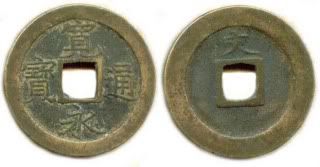
But instead I refer to the crest called mon, or kamon, which was also quite cool and inevitably just as useless.
Regardless, it's likely that you've seen mon around, be it in period films, on things in Japan, on clothing, in Kagrra, PVs, or in PVs that look like they could be Kagrra, PVs.
A mon itself is just a stylised picture of something, but a kamon refers to the real fun part, the crests of specific families used to mark, well, we'll get to that in a minute.
Let's start at the best time, the Heian period, which was over one thousand years ago. The Heian period was basically the period of extreme trite decadence, where, if you didn't know better, you might be tempted to believe that the biggest challenge to face the people of Japan was that the wind might blow in an unlucky direction, and you would be forced to stay at the home of your most admired lady, and to decide whether or not to be a gentleman about it. I'm serious.
But that is hardly the case. Outside of the aristocracy, life was pretty frightening, and inside of it, there was still a good amount of scandal and terror to be had. But I digress. The point is, if His Augustness needed to send a special note of admiration to his lady-friend, or an order to kill somebody he didn't like, he put his personal crest on it so that you would know just where it was coming from.
Of course, in time, everybody of high name had their own crest belonging not to themselves, but to their "clan", which is their family line as well as their many retainers and friends and just whomever the hell they felt like bestowing it upon. When the Sengoku period rolled around, common people weren't even allowed to have last names, let alone their own historic seal, so to be allowed to have one or the other or both was pretty much the greatest thing that could happen to you.
These crests are likened to the heraldic crests of Medieval Europe, the banners and intricate pictures carried by Knights upon their shields and tunics and whatnot. I personally think they are more like the modern day brand logo. Let me explain:
The Warring States Period (known as the Sengoku Era), was a time of mass chaos and confusion for Japan. Basically everybody decided that they didn't like the Ashikaga shogun anymore and the many daimyo (lords) of the provinces began battling it out amongst themselves to decide who the next ruler of the country would be. A few lone daimyo who decided that they did still support the shogun also jumped into the fray to defend the noble position, but they were quickly trampled underfoot.
So all of the important and well-to-do daimyo were now mixed in with the country province rulers, basically just guys with their own spears living in somebody else's castle, so when it came time for battle, the armies and armies marching forward would proudly display their lord's clan's mon. It was very helpful in differentiating if you were about to go to battle with a very respected and well-known clan with the seal skillfully dyed on everything they were fighting with, or if you'd just happened across some loser who just got finished fashioning his own flag.
But it was frowned upon to use someone else's crest that you had no right to claim, so the clan leader's kamon was pretty much his to use as he pleased. And oh, did he please.
This is why I think of it as a brand logo: If he knew (or merely just believed) that his crest would strike fear and respect into the hearts of all who saw it, or he just had the means, you could bet that this kamon would be stamped onto a place of prominence for all to see. He put it on his war flags, he put it on his helmets, he put it on his clothes, on his letters, on his castle. But it didn't stop there. Any little item that he wanted to make sure nobody else could have was branded with his seal as well. Mirrors, carts, doorways, screens, books, or any old thing around the home could be marked with the kamon. And as wartime stretched on, they thought of other uses for it, including possibly the best and most confusing article of clothing ever: the horo.
A horo is basically a large hooped basket, with a very bright cloth stretched over the framework, marked all over with the kamon. It was worn by messengers so that they could easily be found on the battlefield, and if they were riding a horse, it would balloon up so that everybody he rode by would be sure to see it, even people a long distance away.

Stunning.
Anyway, because of how well the amazing technicolour dreamcoat worked out, naturally the kamon was placed on just about everything to be brought into battle. Enormous battle drums, streamers, flags, and sashimono, which were little flags strapped around the foot soldier like a backpack, all of them bore the daimyo's mon. It may seem excessive, but just think how terrified you would have been if you were stepping into battle against this:
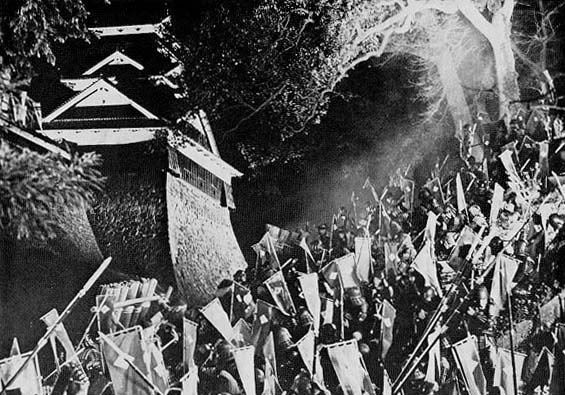
But now with everybody getting their very own little flag to put their clan leader's crest on, the clan leader themselves couldn't afford to be mistaken for a mere foot-soldier. They would often opt to use their very own battle crest so that they personally could be identified in the middle of the campaign, emblazoned on their horse's sash, or carried by a personal guard.
By this time, many lesser soldiers, or even peasants with no notable lineage at all (!) were becoming themselves lords of castles and provinces that they acquired, not by being an heir to the ancestry, but by just taking it from people in battle. So, like any adept company owner, he realised that his clan would need its very own logo, preferably something that looked like someone else of high regard, or even just one that nobody happened to be using at the time. Many would take their crests from very old and well-respected families, claiming to be able to trace their lineage back to them, so several crests made use of having wisteria included, to hearken to the Fujiwara clan (wisteria is the English word for fuji), the clan of the Heian period. Of course, very few people actually had any relation at all, or were just outright lying about it.
In that vein, however, many important retainers would choose their own crests by closely emulating but slightly changing the look of their own kamon based on their lord's crest. Or, like the aforementioned guys who just happened into daimyodom, they could take something that they just thought was cool, or had seen and liked, and some clans ended up having the exact same crest, without actually stealing it.
But stealing somebody's crest wasn't all taboo. Notably, Great Bishamonten himself, the God of War Uesugi Kenshin, who was granted that name and crest so that, despite not being of that family, he could carry along the Uesugi line and take a high-ranking position. Another example is that of Ise Soun, who was a ronin who married into the right family and out of his own intelligence, had people murdered and took over many castles and a massive area of land, and, having become lord of Kamakura, a former capital, declared his name and crest that of the Hojo, so he could be associated with the former regents there by that name.
To this day, crests are still used by families who can trace back their lineage, or the crest of the Emperor, or even companies who want a catchy logo that can still look slightly familliar and remind the viewer of nobility when looking at their product. Even the abstract-looking style of car company logos are based on surprisingly futuristic-looking kamon from way back in the Sengoku period!
So what were kamon supposed to represent? Originally, they went the way of haiku, focusing primarily on nature, plants, animals and scenery. But as more and more "noble" families surfaced (crests granted to the guy who helps watch the gate of the son of the aristocrat who lives far away from the nobility in the country with his wife and children) the number of crests in use amassed into the tens of thousands or more. At this point, pretty much everything was game for your crest, and the insanity of your daimyo could be allowed to show through in what he chose to represent him. Fans, coins, shapes and symbols selected at random, and the extremely lazy people who just scrawled some words they thought sounded cool across their banner, all of them were represented and more.
So now, finally, we will look at some of the most common, interesting, or just downright awesome-looking kamon from this time.
The most famous and common mon you are bound to see is the Seal of the Emperor. It is the chrysanthemum flower with sixteen petals.
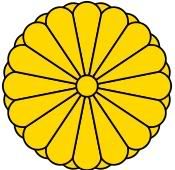
Here are some examples of how the mon is used to mark things, the Imperial Seal appearing on everything from a torii gate to a battleship.
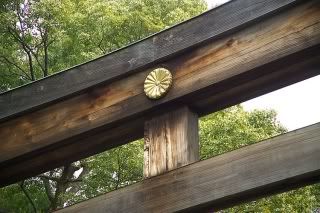
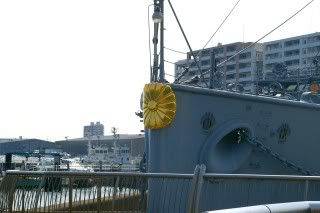
This crest is not allowed to be used outside of the Imperial family, but some samurai and daimyo would use the image of the chrysanthemum (halved or obscured in some way) to signify that they had Imperial blood, much like the use of wisteria for the so-called Fujiwara descendants.
These next crests are also very common to be seen to this day, as they belong to the families of the three unifiers of Japan. The first unifier was Oda Nobunaga, who is my favourite daimyo. He was very capable and ruthless in his mission to bring the country together once more, and had everything going for him at one point, until one of his retainers staged a coup in protest to Nobunaga's cruel tactics, among other things. Inevitably, the retainer, Akechi Mitsuhide, was cut down mere days after taking the reins from Nobunaga, so his shot at unifying the country faded into obscurity.
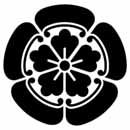
This is the Oda kamon. It is called a mokko, representing a flower encircled by a bird's nest.
After Nobunaga's death, the next one to step up was Toyotomi Hideyoshi, a favourite in samurai movies. The man was born to a no-name family, had no education or connections, and through his own genius was promoted to become Oda Nobunaga's right-hand-man. He also looked exactly like a monkey, and pretty much everyone called him that, when they were not calling him the honourable title of Taiko. So, since he had no crest to call his own, and his lord's crest was probably a bad decision based on the manner of death, he had to choose one for himself.
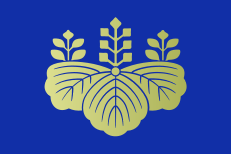
Pretty nice, huh? This crest is the go-shichi-no-kiri, and it represents a paulownia flower. But don't get confused: this crest belongs to the Prime Minister and Imperial Family like the chrysanthemum. This mon, however, was often given to the lord of highest office by the Imperial Family. Oda Nobunaga also had this crest bestowed upon him, and with his death, it was passed on to the next holder of the position, Hideyoshi. Hideyoshi, however, took it a step farther and actually used it as his personal clan crest. (Toyotomi was not his surname, but it was the most prominant name given him, having gone through about five surnames by this time.) So if you see this crest, it could belong to the Prime Minister/Emperor at the time or Hideyoshi. It certainly was an impressive-looking crest to see in battle, and after Hideyoshi's death, it was passed down among family and retainers like any old kamon.
The final unifier of Japan was Tokugawa Ieyasu, who eventually became the unquestionable ruler and ended the Sengoku Period and wars, and was given the until-then abdicated title of Shogun. Like Hideyoshi and Mitsuhide, Ieyasu too was a vassal of the Oda.
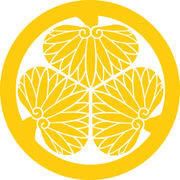
His crest is called maruni-mitsu-aoi, which is a hollyhock flower. This crest is not just the Tokugawa family crest, but also associated with the Tokugawa Shogunate, which lasted from the end of the Sengoku Era in 1600 until the mid-1800s.

This is the crest of the Akechi, carried by Mitsuhide, which you can see on his helmet in the photo of him from Shogun's Ninja. It represents the bellflower, and its simple design is striking.
Many movies of this time use kamon to provide a statement and insight into the characters, as well as help you to identify famous generals.
This symbolic banner was used in the unrivaled film, Seven Samurai.
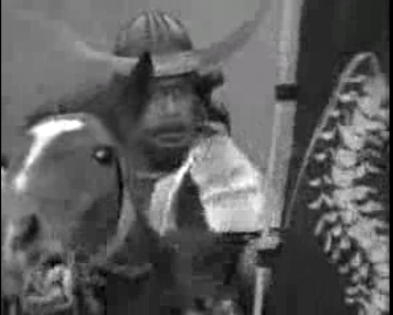
Yes, that's the best person ever, Mifune Toshiro, and on the sashimono behind him is the rather eccentric selection of using an enormous centipede as one's crest.
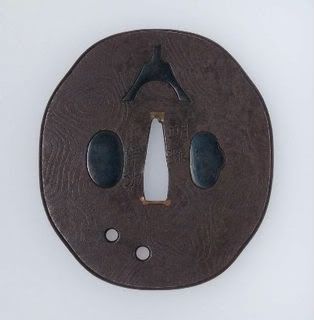
This crest is located on a tsuba, which is guard at the end of the grip of a katana. The kamon were found here, too, and this one is fascinating because it represtents a koto bridge, a piece of the musical instrument.

This imposing-looking crest is very complicated, the family's attempts to make sure it isn't duplicated. It is called take-ni-suzume and it represents sparrows inside bamboo. It in fact belongs to the Date clan, and the most famous member, Date Masamune, is actually noted for battling a daimyo whose crest he believed resembled a bit too closely his family's.

This is the crest of the Taira clan, famously Taira no Kiyomori from the Heian period.
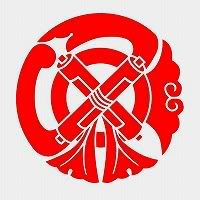
The tachibana is a type of flower and fruit, however its image was being used by a retainer of the Takeda clan, so the Tachibana clan used this kamon, a gion-mamori, or protective amulet.

Many clans used the imagery of fans, and would also have a crest like those seen above stamped onto a fan which, altogether, represented their kamon. As confusing and redundant as that is, this one, belonging to the Akita clan, is quite nice.
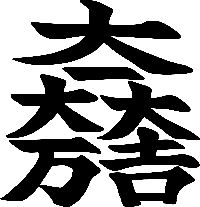
The worst samurai ever was Ishida Mitsunari, and this was his kamon. Right away, the use of kanji sends up warning signs that the family who created this mon was out of ideas. The meaning of this crest, dai-ichi dai-man dai-kichi, means "One for all and all for one will make everyone happy and the world be at peace". Special.
Other popular motifs included birds, whirlpools, trees, the sun, and, in the case of the Hojo and Takeda, dragon scales and diamonds and flowers, represented in abstract form by strategically arranged triangles. There are many, many others, but I think that's more than enough for now. Maybe I'll show some more cool-looking ones at a later date.
Anyway, thanks for reading, and I hope that you enjoyed learning about the crazy cool crests of the notable families of the Sengoku era! And just in case you needed more proof that samurai and kamon are beyond badass, here you go:
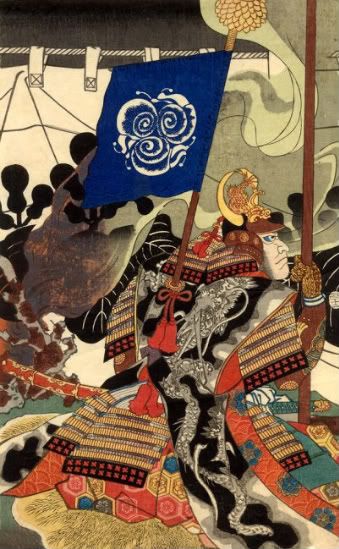
No comments:
Post a Comment